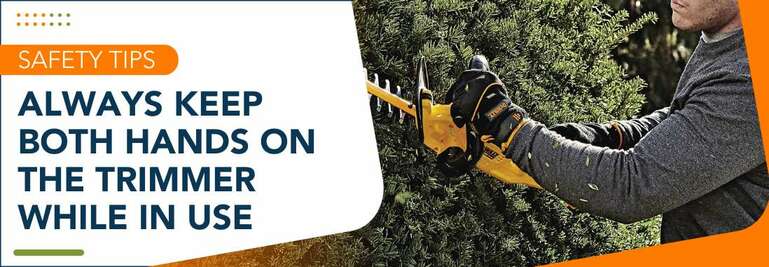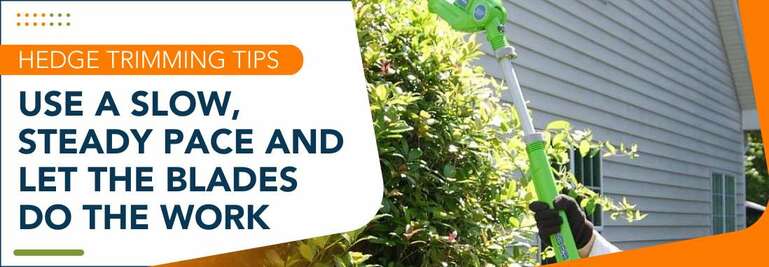The Ultimate Guide To Trimming Your own Bushes

Shrubs, bushes and hedges are arguably the most underrated and undervalued of all landscaping plants. They possess a natural beauty that can enhance the curb appeal of your home, while providing an attractive complement to lawns, trees, gardens and hardscapes, such as walks, patios and stonewalls.
Many types of shrubs and bushes can be grown into a privacy screen, windbreak or living “fence” along a boundary line. Most varieties stay green and vibrant all year. Shrubs, bushes and hedges can even increase the resale value of your home, but only if they’re well maintained and neatly trimmed.
Badly overgrown, misshapen and unkempt shrubs and bushes will have a negative impact on the appearance and value of your home. Fortunately, maintaining these landscaping beauties is relatively easy if you use a hedge trimmer. In a recent survey, nearly one-third of fathers stated they enjoy working on outdoor DIY modifications for their home space—and planting and shaping hedges is the perfect project to create a private getaway in your own backyard.
Below are detailed descriptions of hedge trimmers and advice on how to trim a hedge. There’s also a brief discussion of how to avoid injury while using a hedge trimmer. Read this section carefully, and then study the trimmer’s instructional manual for more specific safety tips.
Types of Hedge Trimmers
There are three basic types of hedge trimmers: gas-powered, corded electric and battery-powered cordless. Each comes in various sizes, ranging from about 16 to 24 inches, which is the length of the cutting bar. The type of trimmer to buy depends on several factors, including the size of the hedge, the location of the hedge on the property, personal preference and cost.

Gas-powered trimmers have powerful engines that cut the thickest branches quickly and cleanly. And because they aren’t tethered to an extension cord, gas-powered trimmers allow you the freedom to work anywhere on the property.
Keep in mind that gas trimmers have two-stroke engines that require you to precisely mix oil and gas to the proper proportions. Prices start at about $180 and go as high as $550, but most models range between $290 and $360.
Pro Tip: Most two-stroke trimmers require a 50:1 fuel-mix ratio. (Check the owner’s manual to confirm.) Achieve this ratio by mixing 2.6 ounces of two-stroke oil into one gallon of 89-octane gasoline. Be sure to use an approved gas container, and shake it to mix the oil and gas prior to filling the trimmer’s fuel tank.
Be advised that if your neighborhood has a homeowner’s association, you should check to see if there are any restrictions against using gas-powered equipment due to noise.
Corded electric hedge trimmers are popular because they’re extremely easy to use, very quiet, and virtually maintenance free. There’s no pull cord, choke, exhaust fumes or gas and oil to mess with. Simply attach the trimmer to an extension cord and you’re ready to start cutting.
Electric trimmers are also very affordable, ranging in price from about $30 to $190, with most models costing between $50 and $75. The obvious disadvantage, of course, is that you’ve got to drag around an extension cord. That limits your range, but also creates one more hazard to avoid when trimming.
Electric hedge trimmers are best for people who have relatively small yards or shrubs in close proximity to an electrical outlet.

Cordless hedge trimmers have been around for quite a few years, but have only recently been taken seriously, thanks to the advent of powerful, long-lasting lithium-ion batteries. They’re growing in popularity because they possess the best qualities of both gas and electric trimmers.
A cordless trimmer provides the freedom to roam around the property untethered, like a gas trimmer, but is also much quieter than an electric trimmer. It starts quickly, produces no exhaust and doesn’t require engine gas or oil.
Performance, power and price are directly related to the size of the battery. Cordless trimmers are available with batteries ranging from 18 volts to 56 volts. Higher-voltage batteries have more power and longer run times, but they’re also heavier and more expensive. Cordless hedge trimmer prices range from $60 to $500, but most cost between $100 and $250.
Pro Tip: When shopping for cordless hedge trimmers, check to see if the battery and charger are included. Many trimmers are sold as bare tools, meaning that you must purchase the battery and charger separately.
Safety Concerns
Hedge trimmers are very easy—and fun—to use. They cut with lightening speed and the precision of a Hollywood hair stylist. However, they’re also potentially dangerous. That’s why it’s critically important to keep both hands on the trimmer at all times, and never, ever hold a branch with one hand while trying to cut it with the trimmer. The risk of serious injury is just too high.
Be aware of your surrounding at all times when using a hedge trimmer. Clear the work area of all obstacles, and look out for hoses and wires that may be hidden by the hedge. Be sure all pets and children are kept well away from the area. When using a corded electric trimmer, be mindful of the extension cord at all times.
Finally, protect yourself by wearing eye goggles, hearing protection, work gloves, a long-sleeve shirt, pants and close-toed shoes.
Pro Tip: Keep a pair of bypass hand pruners in your back pocket and use it to cut branches that are too thick to cut with the trimmer or located in a particularly hard-to-reach spot.
How to Trim a Hedge

The following hedge-trimming tips and techniques are useful for most varieties of shrubs and bushes, regardless of what type of trimmer you’re using. Note that most formal hedges will need to be trimmed three or four times annually to maintain a neat, manicured appearance. Informal hedges, which are allowed to grow into a more natural shape, will require trimming just once or twice per year.
Start cutting near the bottom on the hedge and work your way up toward the top. Move the cutting bar in a slow, steady pace. Allow the cutting action of the blades to do the work. Don’t try to cut too deeply into the hedge on the initial pass; you might lop off too many branches. Instead, make several shallower passes, trimming off just a couple of inches at a time.
It’s important to trim the sides of the hedge at an angle, so that it’s wider at the bottom and slightly narrower at the top. That way, sunlight can reach the lower branches and root system, which helps the entire hedge grow green and lush.
Pro Tip: Don’t trim hedges in early spring when birds are nesting.
To cut the top of the hedge flat, hold the trimmer’s cutting bar perfectly level and slowly guide it left to right, then right to left. Hedge trimmers cut in both directions. Again, only trim off a little at a time.
Small- to medium-size hedges can be trimmed to the desired height freehand. But to accurately trim long hedgerows, it’s best to stretch a taut nylon line between two wooden stakes to represent the finished height of the hedge. Then guide your trimmer along the line to produce a straight, even cut.
After completing the first few passes, set the trimmer down on the ground and use your hands or a leaf rake to pull out the severed branches and leaves. Stand back and examine the hedge. If necessary, make a few finishing passes to trim the hedge to its final shape.
Then, separate the branches by hand and look deep inside the shrub for dead, diseased or damaged branches. If you find any, cut them out with bypass hand pruners.
Pro Tip: Trim hedges in the early morning or late afternoon to prevent the sun from scorching the freshly cut ends of the branches.

If you need to trim really tall hedges, consider buying or renting an extended-reach hedge trimmer. This specialty tool is essentially a standard trimmer that’s attached to a long, adjustable shaft. It provides the easiest and safest way to trim tall branches without having to stand on a ladder.
In conclusion, be aware that you’ll probably feel a little awkward and tentative the first time you use a hedge trimmer, but don’t get discouraged. Within an hour or so, you’ll become comfortable with the way the trimmer feels in your hands. Just remember: Don’t rush, work at leisurely pace and allow the blades to do the cutting. Before long, you’ll be trimming hedges like a pro.
.jpg)
Quick Summary
Maintaining your bushes and hedges doesn’t have to be intimidating. With the right tools, safety precautions, and techniques, you can easily keep your landscaping looking polished and beautiful. Whether you’re working with a gas-powered, electric, or cordless hedge trimmer, following these tips will help you achieve professional-quality results. Take your time, practice, and soon you’ll be trimming like a pro. Your well-manicured bushes will not only enhance your home’s appeal but also give you a sense of accomplishment. Happy trimming!
.jpg)
Written by :
Do-it-yourself expert Joe Truini has taught many homeowners the finer points of outdoor landscaping, including how to use hedge trimmers. Joe writes his tips for the Home Depot, where you can research a large variety of trimmer styles.





 Share
Share











